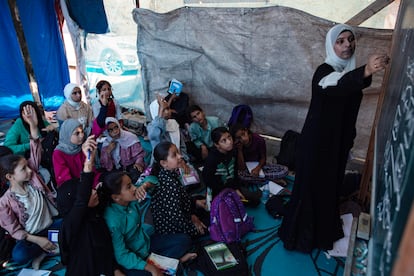‘The bomb exploded right on the roof’: Every day across the world, there are an average of eight attacks on education
A report concludes that, in 2022 and 2023, attacks against students and teachers increased by 20%, as did the military use of schools. The worst hit places were Palestine, Ukraine, the Democratic Republic of the Congo and Myanmar


Students injured by projectiles fired at a university women’s dormitory in Sudan. A U.N. school in the Al Maghazi refugee camp in the Gaza Strip bombed by Israel. Two primary school students killed in a Myanmar village on their way home from class. Some 350 people trapped by Russian military forces in a Ukrainian school. Teachers and students threatened inside their classrooms by an armed group in the region of Santander, in Colombia.
Every day, an average of eight attacks against education are recorded globally. These range from assaults against students or teachers, to the military use of schools. This is according to the Global Coalition to Protect Education from Attack (GCPEA), which has just published its report for 2022 and 2023.
Over the course of those two years, more than 10,000 students and educators died violently, were injured, or were kidnapped, a figure that represents an increase of 10% compared to the 2020-2021 period. In addition, at least 6,000 attacks against schools, universities, students and teachers — as well as cases of military use of educational establishments — were identified. That is, 20% more than in the previous two years, according to the GCPEA, which was formed in 2010 by various entities dedicated to education in contexts of emergency and conflict.
In 2022 and 2023, the countries with the highest number of attacks against education were Palestine, Ukraine, the Democratic Republic of the Congo (DRC) and Myanmar. “In total, we’ve analyzed 28 countries in conflict. This is the seventh report we’ve done and the increase in global attacks has been more significant than in previous ones,” says Jerome Marston — one of the authors of the research — in an interview with EL PAÍS.
The countries that recorded the greatest increase in attacks against education compared to the previous two years were Ukraine, where the war worsened; Sudan, where conflict broke out in April 2023; Palestine, due to the war on Gaza; Syria — where students were recruited by armed groups and attacks against educational centers increased — and, finally, Nigeria, where the number of schools converted into barracks, bases, or weapons depots increased. In total, the GCPEA recorded 1,000 cases in which educational centers were used for military purposes — a figure that clearly increased compared to the previous period. In addition to Nigeria, a significant number of these incidents were recorded in Afghanistan and Myanmar.
What qualifies as an attack on education? The study identifies several types: attacks against educational centers, against students and teachers, the military use of educational centers, recruitment of boys and girls to be used as child soldiers, sexual violence in classrooms and women attacked in the educational field for the simple act of being women. “Female students and educators were directly targeted because of their gender in more than 10 countries. Girls are the first to drop out and the last to return to classes after attacks on education, making these attacks a gender equality issue,” the authors emphasize.
Schools attacked in Afghanistan, Ukraine and Gaza
“She always said, ‘Even if I am killed, let it be in the name of education,’” says the father of a 19-year-old Afghan woman. She died at a private educational center in Kabul, in September 2022, when an attacker detonated an explosive belt. The bombing left a total of 54 fatalities and more than 100 injured. Most of the victims were young women from the Hazara minority community.
Recently, in mid-June, 1,000 days passed since the Taliban closed the doors of secondary education to women, after having previously denied them the possibility of continuing to study at university. Less than three years after the return of the fundamentalists to power, in August 2021, women have practically no presence in public and professional spaces in Afghanistan.
According to this report released by the GCPEA, Afghanistan is also one of the countries where women — along with the educational centers where they study or work — are especially targeted. The GCPEA also identified more than 140 attacks in 2022 and 2023, a period in which at least 98 Afghan women and girls — both students and higher education teachers — were also detained. “The study counts specific attacks on students or centers, but it cannot reflect, for example, that the doors of the universities have been closed to women, which is an immense offense,” Marston explains.
“I was afraid to go to class every day in Afghanistan, but I was even more afraid not to go. Schools were frequent targets of attacks and we knew that we were exposing ourselves to a tragedy every day. It was an act of courage. But in a society dominated by men, the school was my refuge,” said Mina Bakhshi, an Afghan refugee in the United States, during the presentation of the report, in reference to the months before the return of the Taliban, who last held power in Afghanistan between 1996 and 2001. “Now, girls in Afghanistan are more vulnerable, because they don’t have school as a refuge. They have no choice. Thousands of young women locked in their homes dream of going back to school,” she added.
Palestine also recorded disturbing results as a result of the Israeli bombardment and razing of schools and universities. At least 640 attacks were registered in the period that was studied. Marston warns that the study concluded on December 31, 2023. Since then, education in Gaza — where the war continues — has come under renewed attack. “Between the escalation of hostilities in October and December 2023, the U.N. reported that at least 352 schools were damaged in the Gaza Strip, representing more than 60% of all schools,” the report states.
In Ukraine, 700 attacks on schools by Russian forces were recorded between 2022 and 2023, mainly in the southern and eastern regions, involving the use of explosive weapons, including airstrikes. But this is not unusual: attacks on schools occur in many other places around the world.
“We were terrified because it was the first time it happened, and most of the students there were traumatized because the bomb exploded right on the roof of the school,” a student from a school affected by clashes between the army and an armed group told GCPEA investigators in the Philippines, in March 2023. In-person classes were suspended in many schools. The clashes affected 112 educational centers and more than 30,000 students.
Informing, protecting and prosecuting
At the same time, there were some countries where the attacks against education were reduced, thanks to the calming of conflicts. The report highlights the cases of the Central African Republic, Libya, Mali and Mozambique.
To reduce the number of attacks, the coalition recommends signing and putting into practice the Safe Schools Declaration, an intergovernmental political agreement dedicated to protecting education in armed conflict. Started in 2015 and led by Norway and Argentina, it has already been signed by 120 countries. In addition, states are advised to report more on these attacks, prosecute those responsible, provide assistance to survivors and place special emphasis on the duty to anticipate and mitigate the impact of attacks. The Declaration also asks that states guarantee the operation of schools to the greatest extent possible during armed conflicts, while protecting educational centers and minors.
Finally, the report warns of the long-term repercussions of disruptions to education due to conflict and attacks. In 2022, the conflict in North Kivu — a province in the Democratic Republic of the Congo (DRC) — forced Muhawe Wimana to flee the village where she lived with her seven-year-old son, Isaac. He was unable to finish the school year. In 2023, temporary learning centers were established in the Bushagara displacement camp, so that boys and girls could continue learning.
“The children will be busy at school during the day. They will come home, do their homework and then go to bed. This routine gives us a bit of normalcy and it keeps the children out of harm’s way,” the mother said, with a sigh of relief.
Translated by Avik Jain Chatlani.
Sign up for our weekly newsletter to get more English-language news coverage from EL PAÍS USA Edition
Tu suscripción se está usando en otro dispositivo
¿Quieres añadir otro usuario a tu suscripción?
Si continúas leyendo en este dispositivo, no se podrá leer en el otro.
FlechaTu suscripción se está usando en otro dispositivo y solo puedes acceder a EL PAÍS desde un dispositivo a la vez.
Si quieres compartir tu cuenta, cambia tu suscripción a la modalidad Premium, así podrás añadir otro usuario. Cada uno accederá con su propia cuenta de email, lo que os permitirá personalizar vuestra experiencia en EL PAÍS.
¿Tienes una suscripción de empresa? Accede aquí para contratar más cuentas.
En el caso de no saber quién está usando tu cuenta, te recomendamos cambiar tu contraseña aquí.
Si decides continuar compartiendo tu cuenta, este mensaje se mostrará en tu dispositivo y en el de la otra persona que está usando tu cuenta de forma indefinida, afectando a tu experiencia de lectura. Puedes consultar aquí los términos y condiciones de la suscripción digital.










































